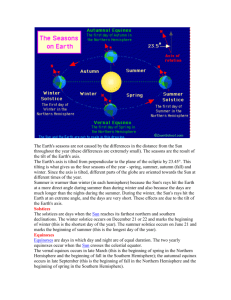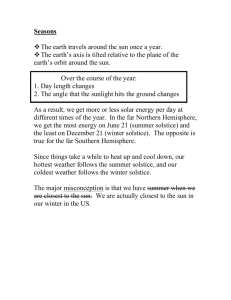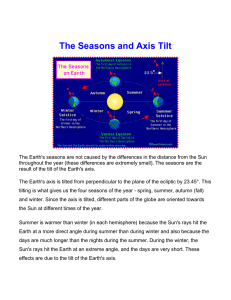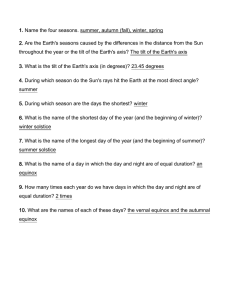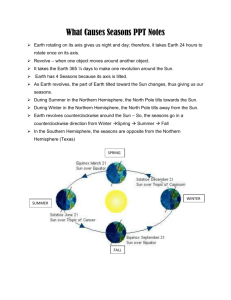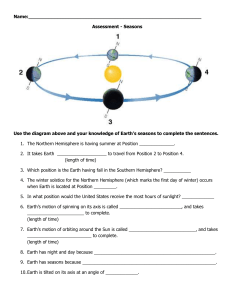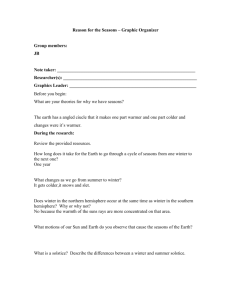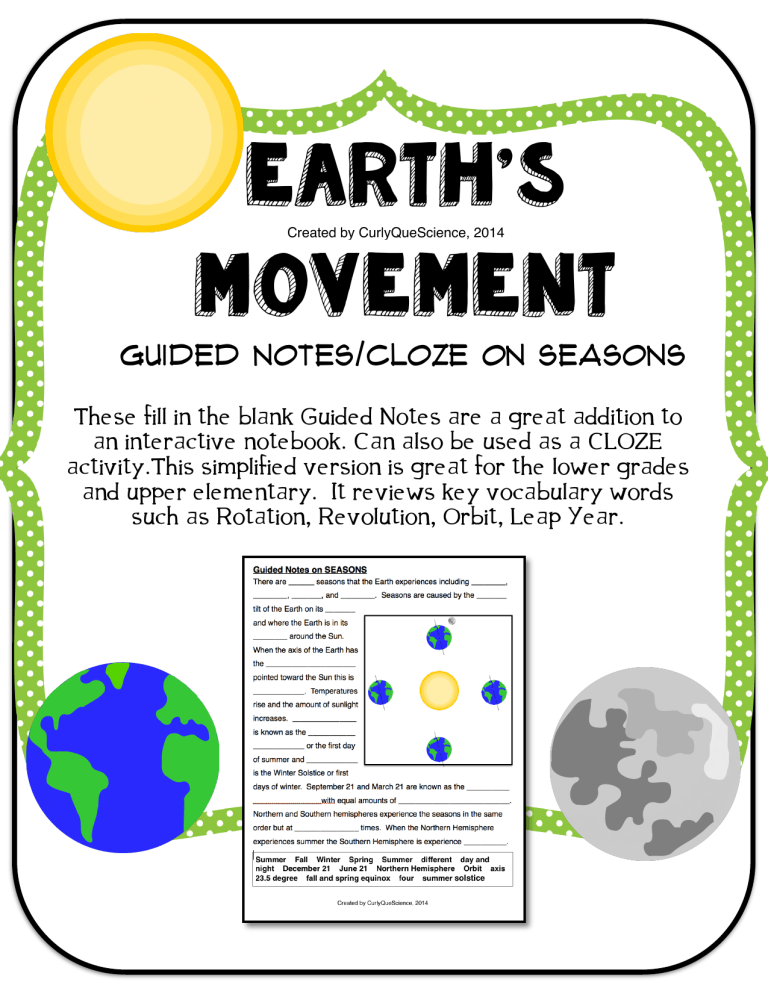
Earth’s Created by CurlyQueScience, 2014 Movement Guided Notes/CLOZE on seasons These fill in the blank Guided Notes are a great addition to an interactive notebook. Can also be used as a CLOZE activity.This simplified version is great for the lower grades and upper elementary. It reviews key vocabulary words such as Rotation, Revolution, Orbit, Leap Year. Created by CurlyQueScience, 2014 Guided Notes on SEASONS There are ______ seasons that the Earth experiences including ________, ________, _______, and ________. Seasons are caused by the _______ tilt of the Earth on its _______ and where the Earth is in its ________ around the Sun. When the axis of the Earth has the _____________________ pointed toward the Sun this is ____________. Temperatures rise and the amount of sunlight increases. _______________ is known as the ___________ ____________ or the first day of summer and ____________ is the Winter Solstice or first days of winter. September 21 and March 21 are known as the __________ ________________with equal amounts of __________________________. Northern and Southern hemispheres experience the seasons in the same order but at _______________ times. When the Northern Hemisphere experiences summer the Southern Hemisphere is experience __________. Summer Fall Winter Spring Summer different day and night December 21 June 21 Northern Hemisphere Orbit axis 23.5 degree fall and spring equinox four summer solstice Created by CurlyQueScience, 2014 Guided Notes on SEASONS There are four seasons that the Earth experiences including summer, fall, winter and spring. Seasons are caused by the 23.5 degree tilt of the Earth on its axis and where the Earth is in its orbit around the Sun. When the axis of the Earth has the Northern Hemisphere pointed toward the Sun this is summer. Temperatures rise and the amount of sunlight increases. June 21 is known as the Summer Solstice or the first day of summer and December 21 is the Winter Solstice or first days of winter. September 21 and March 21 are known as the fall and spring equinox with equal amounts of day and night. Northern and Southern hemispheres experience the seasons in the same order but at different times. When the Northern Hemisphere experiences summer the Southern Hemisphere is experience winter. Summer Fall Winter Spring Summer different day and night December 21 June 21 Northern Hemisphere Orbit axis 23.5 degree fall and spring equinox four summer solstice Created by CurlyQueScience, 2014 Thank you for downloading this Curly Que Science product! I really hope that you will find it useful, and am so excited that you decided to use this activity in your classroom. This activity can be used as a whole group, small group and/or individual activity. Curly Que Science Please check out other products in my store. Lunar Cycle Dominoes Lunar Cycle Vocabulary, Definition and Picture Sort Lunar Cycle Vocabulary Lunar Cycle Wheel Model Create A Food Web Bundle Weathering, Erosion and Deposition Fold and Sort Digestive System Structure and Function Foldable Label the Digestive System Excretory System Sort, Fold, Diagram and Clipart Human Body Task Cards Photosynthesis Bundle Heat Transfer (Conduction, Convection and Radiation) Bundle and many others to come! **All pictures, graphics, and artwork in our lessons are either purchased legally for use or are created by Curly Que Science** Copyright Notice: The original purchaser of this document is granted permission to reproduce the pages in needed quantities for the purchaser’s classroom only. Minor editing is allowed; the document remains under copyright even when edited. Duplication for other classes or by other teachers or for use in wide distribution as within a school district or on the internet in any for is strictly forbidden. Images used: Sun, Moon and Earth Created by CurlyQueScience, 2014
